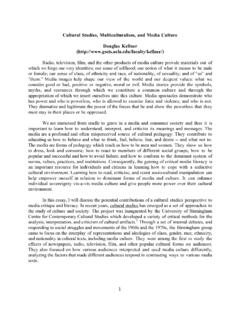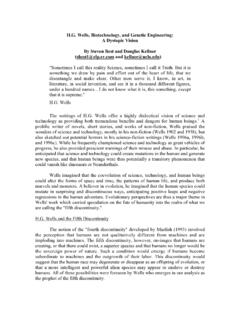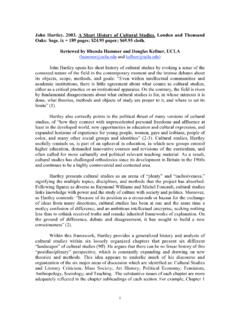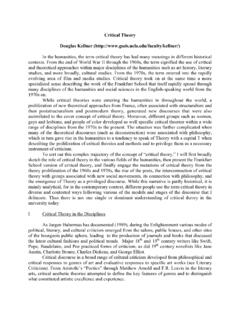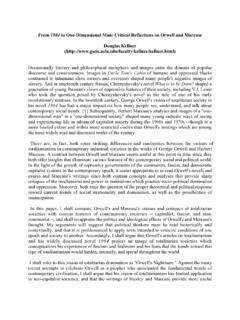Transcription of Third Wave Feminism. Sexualities, and the Adventures of ...
1 1 Third Wave Feminism. Sexualities, and the Adventures of the Posts Rhonda Hammer and Douglas Kellner In engaging the issue of contemporary feminism and sexuality, we begin by situating contemporary debates within feminism in the United States in the context of so-called feminist waves, with emphasis on what some are calling the Third Wave of feminism. Next, we discuss key feminist debates on sexuality as presented in the 1982 Barnard conference on women and sexuality articulated around the themes of pleasure and danger and the 1983 book Powers of Desire. The Politics of Sexuality. Finally, we take on the issue of so-called postsexuality in the context of French and debates over postmodernism and posthumanism and the proliferation of discourses of the post.
2 Waves of Feminism While doing research on violence against women, children and the elderly for my book Antifeminism and Family Terrorism,1 I continued to come across a group of women, who called themselves feminist, postfeminists or Third wave feminists . Yet these so-called feminists were in actuality attacking and demonizing feminisms. In fact, most of these women seemed to be assailing feminisms which addressed issues of sexuality, the social construction of gender, and, especially, violence against women and children. For example, Camille Paglia - who calls herself a feminist, but should be seen as an antifeminist or feminist impersonator - employed an essentialist and biologically determined approach to celebrate masculinity, and attack feminisms.
3 As she describes it in her 1991 best selling book, Sexual Personae 2 Lust and aggression are fused in male more testosterone, the more elevated the libido. The more dominant the male, the more frequent his contributions to the genetic pool. Even on the microscopic level, male fertility is a function not only of sperm but of their mobility, that is, their restless movement, which increases the chance of conception. Sperm are miniature assault troops, and the ovum is a solitary citadel that must be rewards energy and , arguing from the milder woman s view, completely misses the blood-lust in rape, the joy of violation and may be less prone to such fantasies because they physically lack the equipment for sexual violence.
4 They do not know the temptation of forcibly invading the sanctuary of another body (Paglia, 1991, 24). It was within this context, that I began to investigate the ideas and interventions of this so-called feminist Third wave, a term that has been used by a number of women, as well as popular media, to describe contemporary versions of feminisms that evolved from the early 1980s to the present. Some have associated this term with young feminists who were influenced by the legacies of feminism's second wave, which began in the mid-1960s. Yet the term is highly contested and has been employed to describe a number of diverse feminist and anti-feminist theories and practices. Like "feminism" in general, there is no definitive description or agreed upon consensus of what constitutes a feminist Third Wave.
5 Within this loose category of feminism's Third wave are a multiplicity of movements, philosophies and practices. However, to even talk about a feminist Third wave necessitates an understanding of what characterizes those periods and/or 3 movements that have been identified as first and second wave feminisms. And it is also essential to recognize that young women, girls and/or radical youth cultural dissidents have always been central to feminisms on-going local and global developments before, within and between these hypothetical waves. The feminist "first wave" is generally identified with the mobilization of strong feminist movements in the mid nineteenth and early twentieth centuries in Europe and North America which were concerned with a number of egalitarian and radical issues which included equal rights for women, educational and legal reform, abolition of slavery, and "suffrage" (the right to vote).
6 Although the first wave is often characterized as the struggle for women's suffrage, a plethora of feminist, humanitarian and radical politics were advanced during this period--especially those which were identified as falling under the rubric of "the tyranny of men." Issues of sexuality and pleasure, for women, as well as reproductive rights and birth control, for example, were highly contentious dimensions of the first wave. It is within this context that many young women, in particular, began to question the institution of marriage, in which women and children were literally the property of men. During the initial rise of western feminisms, pro-feminist philosopher and feminist writer and partners John Stuart Mill (1806-1873) and Harriet Taylor (1807-1858) penned a number of essays apart and together, including Taylor's the Enfranchisement of Women (1851) and Mills The Subjection of Women (1869) which advocated more egalitarian partnerships in marriage, based on full citizenship, voting rights and equal educational opportunities for women.
7 Taylor, especially, supported the rights of women to work outside of the home in the "public domain," but asserted that 4 working wives with children could only do so with a number of servants to look after her domestic responsibilities. This kind of perspective characterized the more elitist attitudes of some of the first wave. Regardless, it is hardly surprising then that numbers of first wave feminists not only demanded the right to vote, but also fought for massive reforms in the arenas of property rights, labor, education, divorce laws, child custody, prison conditions and sexual liberation, to name a few. Numerous first-wavers also addressed the mostly legal, inhumane practices of rape and the abuse of women and children, especially by husbands and fathers.
8 Radical cultural reforms in the arenas of women's art, dance, literature, journalism and music were also a large part of the feminist first wave (Isadora Duncan, Virginia Wolf and Josephine Baker, to name a few). Although much of the European first wave feminisms' finds its rudiments in the libertarian and enlightenment principles and practices of the French Revolution, the anti-slavery movement, especially in the United States, is identified as one of the most important influences in the development of this feminist first wave. It was the anti-slavery movement, many contend, that inspired numerous white women and women of color to politically organize against their own oppression. In fact, the first women's rights convention, in Seneca Falls New York, in 1848 -- which demanded an end to all discrimination based on sex -- was initiated in response to the prohibition of women's participation in the 1840 World's Anti-Slavery convention in London (an organization which supported equal rights for black men, but not for women).
9 Many of the most powerful and influential first wave feminists were black women, some of whom were ex-slaves like Sojourner Truth (1797-1883) and 5 Harriet Tubman (1843-1913), who were also involved in abolitionist movements and the Underground Railroad (a covert escape route to the North and Canada from the Southern slave states)(Watkins, et al. 1992). Indeed, ex-slave, teacher, feminist and civil rights advocate, Ida B. Wells (1862-1931) was also a famous journalist who wrote biting condemnations of the common practice of lynching of black men and women and the injustice of segregation in the United States. She, like so many other first-wave women of color, understood that issues of emancipation had to be pursued within the intersections of race and gender.
10 (It is interesting to note, however, that some first wave feminists , like Elizabeth Cady Stanton (1815-1902), who was one of the major organizers of the Seneca Falls women's right convention and had co-authored the famous 1848 Seneca Falls Declaration of Sentiments, did not support the ratification of the Fifteenth Amendment to the American constitution because it only provided citizenship and voting rights to black men) (Tong, 1998, 22). The end of the first wave is often associated with the periods in the early twentieth century during and after World War One (1914-1918), when most women, in the Western world, were granted the rights to vote. Although feminist, human rights and social justice struggles continued throughout the early 1920s to the mid 1960s, it is not until the 1960s that what is called the "second wave" of feminisms rolls in.
